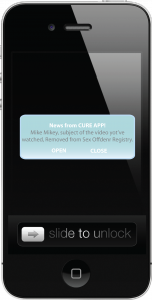Susanna and I (Miho) are in Team CURE, and we had our first Google hangout meeting today with Josh, Galen and Andrew – it was great to finally talk with them after a bunch of email exchange!
CURE works on criminal justice system from the perspective of human rights – and for this CoDesign class, they would like to work on the issue around sexual offenders who are highly marginalized community.
Josh, Galen and Andrew have been very helpful providing Susanna and me a lot of article and other medias – because it is such a new topic for both of us – and we began to have some ideas of projects. All of the ideas cover either/both of two main things.
1. Legal definitions of sexual offenders include a very large spectrum of people – from those who did public urination to those who committed serious rapes – and they will be all put in Registry and usually cannot get out of it.
2. How the Registry affects very the sexual offenders’s lives after they are released from the prison (restriction on where to live, where to be, activities, etc.) which is very different from any kinds of restrictions on other serious criminals
We are gearing towards creating an interactive multimedia that increase the general awareness of people on these two points above. The keywords for us are map, personal stories and statistics. More detailed information would come later. 🙂
We’ve had a very dense (and very fun) talk today, and Susanna and I are now digesting the contents while brainstorming some ideas for DiscoTech workshop. Some ideas we have are
1. Mapping where sexual offenders can’t live/have other restrictions in Boston (with colored pencils etc.)
2. Asking people what alternative laws to be made, and compare the results to the currents ones
3. Illustraton Charrete of laws
4. Question generations for storytelling
5. Roleplay (testify as a sexual offender) and compare with the actual testimonies
6. Reaction recording while people watch videos related
7. Some sort of discussion generating workshop: “can you list what offences will land you on the registry?” “what do you think the restrictions are on offenders?” “what do you think the consequences are of being on the registry?”
and more! These ideas above are mostly what we brainstormed before having the hangout meeting, so later this week, we will have a more detailed/polished workshop idea for DiscoTech.



